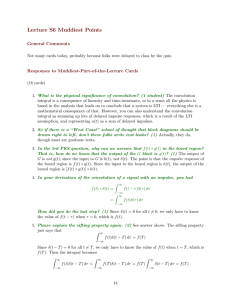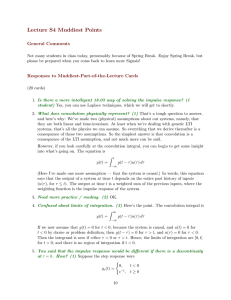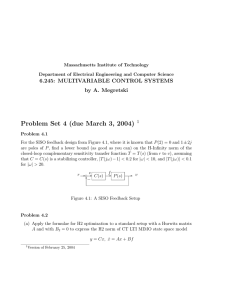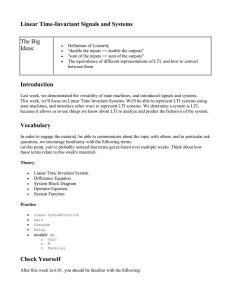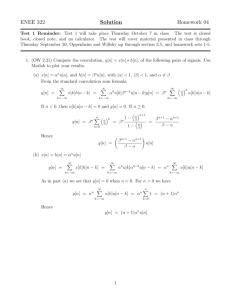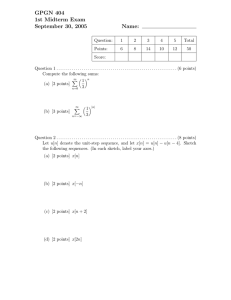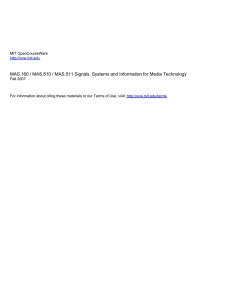Chapter 3 CT LTI Systems Updated: 9/16/13
advertisement
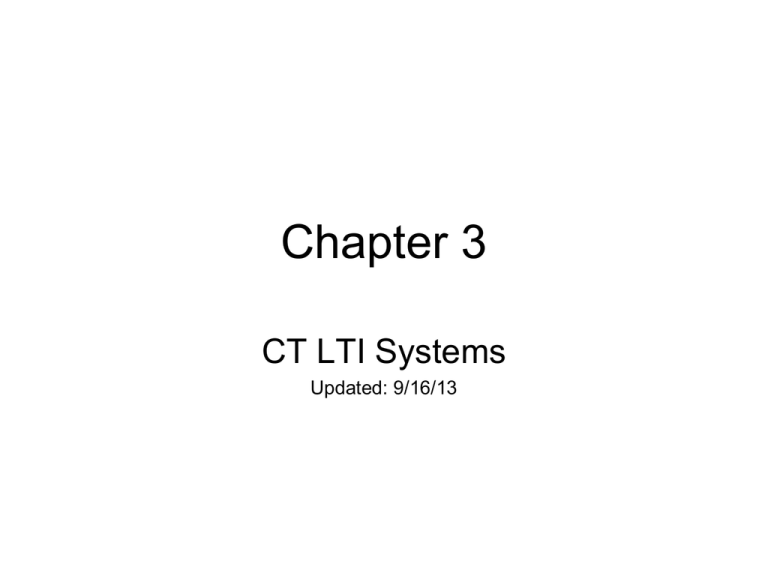
Chapter 3
CT LTI Systems
Updated: 9/16/13
A Continuous-Time System
• How do we know the output?
X(t)
y(t)
System
LTI Systems
• Time Invariant
– X(t) y(t) & x(t-to) y(t-to)
• Linearity
– a1x1(t)+ a2x2(t) a1y1(t)+ a2y2(t)
– a1y1(t)+ a2y2(t)= T[a1x1(t)+a2x2(t)]
• Meet the description of many physical systems
• They can be modeled systematically
– Non-LTI systems typically have no general
mathematical procedure to obtain solution
What is the input-output relationship for LTI-CT Systems?
Convolution Integral
• An approach (available tool or operation) to describe the
input-output relationship for LTI Systems
X(t)=d(t)
• In a LTI system
y(t)=h(t)
LTI System
d(t) h(t)
– Remember h(t) is T[d(t)]
– Unit impulse function the impulse response
• It is possible to use h(t) to solve for any input-output
relationship
X(t)
y(t)
LTI System: h(t)
• One way to do it is by using the Convolution Integral
Convolution Integral
• Remember
X(t)=Ad(t-kto)
y(t)=Ah(t-kto)
LTI System
• So what is the general solution for
X(t)
y(t)
LTI System
?
Convolution Integral
• Any input can be
expressed using the
unit impulse function
Proof:
d (t ) d (t )
Sifting
Property
(t )d (t t )dt (t )
o
o
x(t )
x( )d (t )d
to and
integrate by d
x(t )d (t to ) x(to )d (t to )
x(t )d (t )d x( )d (t )d
x(t ) d (t )d x(t )(1) x(t )
X(t)
y(t)
LTI System
Convolution Integral
• Given
X(t)
y(t)
LTI System
• We obtain Convolution
Integral
• That is: A system can be
characterized using its
impulse response:
y(t)=x(t)*h(t)
y (t ) T {x(t )}
h(t ) T {d (t )}
h(t ) T {d (t )}
y (t ) T x( )d (t )d
Linearity : y (t )
x( )T d (t )d
X(t)
y(t)
LTI System: h(t)
y (t )
x( )h(t )d
Do not confuse convolution with multiplication!
y(t)=x(t)*h(t)
By definition
Convolution Integral
X(t)
y(t)
LTI System: h(t)
Convolution Integral - Properties
x(t ) * h(t ) h(t ) * x(t )
[ x(t ) * h1 (t )] * h2 (t ) x(t ) *[h1 (t ) * h2 (t )]
• Commutative
• Associative
• Distributive
x(t ) *[h1 (t ) h2 (t )] [ x(t ) * h1 (t )] [ x(t ) * h2 (t )]
• Thus, using commutative property:
x(t )
x( )h(t )d h( )x(t )d
Next: We draw the block diagram representation!
Convolution Integral - Properties
•
•
•
Commutative
Associative
Distributive
x(t ) * h(t ) h(t ) * x(t )
[ x(t ) * h1 (t )] * h2 (t ) x(t ) *[h1 (t ) * h2 (t )]
x(t ) *[h1 (t ) h2 (t )] [ x(t ) * h1 (t )] [ x(t ) * h2 (t )]
Simple Example
• What if a step unit function is
the input of a LTI system?
u(t)
y(t)=S{u(t)}=s(t)
LTI System
• S(t) is called the Step
Response
y (t ) S{u (t )}
y (t ) s (t ) h(t ) x(t ) h(t ) u (t )
y (t ) s (t ) u ( )h(t )d h( )u (t )d
t
h( )d
Step response can be obtained by
integrating the impulse response!
Note : h(t ) y (t ) / dt s (t ) / dt
Impulse response can be obtained by
differentiating the step response
Example 1
• Consider a CT-LTI system. Assume the impulse response
of the system is h(t)=e^(-at) for all a>0 and t>0 and input
x(t)=u(t). Find the output.
y (t ) h(t ) x(t ) h(t ) u (t )
u(t)
h(t)=e^-at
y (t ) h( )u (t )d
(e
a
y(t)
Because t>0
u ( ) u (t )d
1
(
e
d
(e
a
t
a
0
at
1)
Draw x(), h(), h(t-),etc. next slide
1
(1 e at )u (t )
a
The fact that a>0 is not an issue!
Example 1 – Cont.
y(t); for a=3
y(t)
*
t
t
y (t ) h(t ) x(t ) h(t ) u (t )
U(-(-t))
t<0
U(-(-t))
t>0
y (t ) h( )u (t )d
(e
a
u ( ) u (t )d
Remember we are plotting it over
and t is the variable
1
(
e
d
(e
a
t
a
0
1
(1 e at )u (t )
a
at
1)
Example 1 – Cont.
Graphical Representation (similar)
a=1
In this case!
http://www.wolframalpha.com/input/?i=convolution+of+two+functions&lk=4&num=4&lk=4&num=4
Example 1 – Cont.
Graphical Representation (similar)
Note in our case
We have u(t) rather
than rectangular
function!
http://www.jhu.edu/signals/convolve/
Example 2
• Consider a CT-LTI system. Assume the impulse response
of the system is h(t)=e^-at for all a>0 and t>0 and input
x(t)= e^at u(-t). Find the output.
x(t)
y(t)
h(t)=e^-at
y (t ) h(t ) x(t ) h(t ) u (t )
y (t )
x( )h(t )d
(e
a
(
u ( ) e a ( t ) u (t ) d
Note that for
t>0; x(t) =0; so
the integration
can only be
valid up to t=0
( (e d (e 21a e
t 0 e
at
t
2 a
at
2 at
1 at
e
2a
( (e d (e 21a [1 0] 21a e
t 0 e
at
0
2 a
at
at
y (t )
1 a t
e a 0
2a
Draw x(), h(), h(t-),etc. next slide
Example – Cont.
x(t)= e^at u(-t)
*
y (t ) h(t ) x(t ) h(t ) u (t )
y (t ) h( )x(t )d
?
y (t ) h(t ) x(t ) h(t ) u (t )
1 a t
y (t )
e a 0
2a
h(t)=e^-at u(t)
Another Example
notes
Properties of CT LTI Systems
•
When is a CT LTI system memory-less (static)
h(t ) Kd (t ) y (t ) Kx(t )
•
When does a CT LTI system have an inverse system (invertible)?
h(t ) * hi (t ) d (t )
•
When is a CT LTI system considered to be causal? Assuming the
input is causal:
t
t
0
0
y(t ) x( )h(t )d h( )x(t )d
•
When is a CT LTI system considered to be Stable?
notes
y (t )
h(t ) dt
Example
• Is this an stable system?
h(t ) e 3t u (t )
y (t )
h(t ) dt
0
3t
3t
e
u
(
t
)
dt
e
dt 1 / 3
• What about this?
notes
h(t ) e3t u (t )
Differential-Equations Models
• This is a linear first order differential equation with
constant coefficients (assuming a and b are constants)
• The general nth order linear DE with constant equations
is
Is the First-Order DE Linear?
• Consider
• Does a1x1(t)+ a2x2(t) a1y1(t)+ a2y2(t)?
notes
• Is it time-invariant? Does input delay results in an output delay by
the same amount?
notes
• Is this a linear system?
+
X(t)
Sum
e(t)
a
Integrator
Y(t)
Example
• Is this a time invariant linear system?
R
V(t)
Ldi(t)/dt + Ri(t)= v(t)
a= -R/L
b=1/L
y(t)=i(t)
x(t) = V(t)
L
Solution of DE
• A classical model for the solution of DE is
called method of undermined coefficients
– yc(t) is called the complementary or natural
solution
– yp(t) is called the particular or forced solution
Solution of DE
Thus, for
x(t) =constant yp(t)=P
x(t) =Ce^-7t yp(t)= Pe^-7t
x(t) =2cos(3t) yp(t)=P1cos(3t)+P2sin(3t)
Example
• Solve
– Assume x(t) = 2 and y(0) = 4
yc(t) = Ce^-2t; yp(t) = P; P = 1
y(t) = Ce^-2t + 1
y(0) = 4 C = 3 y(t) = 3e^-2t + 1
– What happens if
notes
Schaum’s Examples
• Chapter 2:
– 2, 4-6, 8, 10, 11-14, 18, 19, 48, 52, 53,
